By mid-February, the lowlands of Myanmar were sweltering under an unforgiving sun. With temperatures in the mid-90’s and 60% humidity, I fled the crowded streets of Mandalay and headed for the hills. Rather than rely on slow, uncomfortable trains like the Circular Train in Yangon, I splurged a little and hired a “taxi.” Taxis in Myanmar are somewhat of a misnomer. In essence, they are rental cars, but since foreigners are not allowed to drive them, they come with a driver, and in my case, a translator as well.
Aung, my driver, spoke no English, but even if he could it would have been unintelligible. An ever-present chaw of betel nut tucked into his cheek made him look like a chipmunk hoarding too many acorns and rendered him mute. Whenever my translator, Win, asked him a question, Aung was forced to pull over and spew a stream of dark red liquid onto the side of the road before answering. Win’s English was somewhat limited, but we managed to understand one another well enough, and I left it to them to decide which sites to show me.
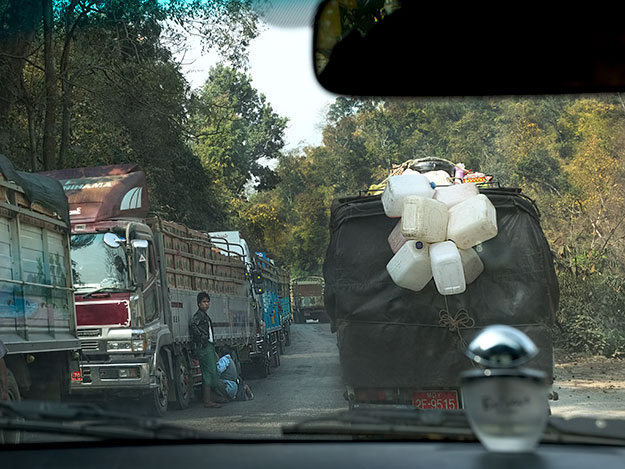
We left Mandalay early one morning, hoping to avoid the city’s horrid traffic, but just outside the city we slowed to a crawl. Before us stretched a long line of trucks and tankers, overloaded with rare teak wood, huge sacks of rice, raw rubber, fruits, oil, and gas, all bound for China. The only road leading to the northeastern hill stations of Myanmar, unfortunately, is also the main artery through which most exports travel to China. For the next hour and a half we inched forward through suffocating brown dust kicked up by the tractor-trailers. Broken down trucks on the side of the road, some of them toppled on their sides from too-heavy loads, made for excruciatingly slow progress. We finally emerged onto the high plateau and Aung pulled over at a photo viewpoint but I didn’t even raise my camera; haze hung so heavy in the air that nothing of the valley below was visible.

Atop the ridge, the dusty desert gave way to evergreen and teak forests. By the time we reached Pyin Oo Lwin the landscape was a veritable oasis. I breathed in cool air perfumed with pine and instantly understood what had attracted the British in colonial times. Seeking respite from the suffocating heat of the valley, they constructed a military outpost in a tiny Shan village and named it Maymyo in honor of their British commander Colonel May. The Brits built colonial mansions and planted formal gardens and Maymyo quickly grew into the the summer capital of British Burma. Though the military government renamed the town to Pyin Oo Lwin after seizing power in the 1960’s, many locals still refer to it as Maymyo.
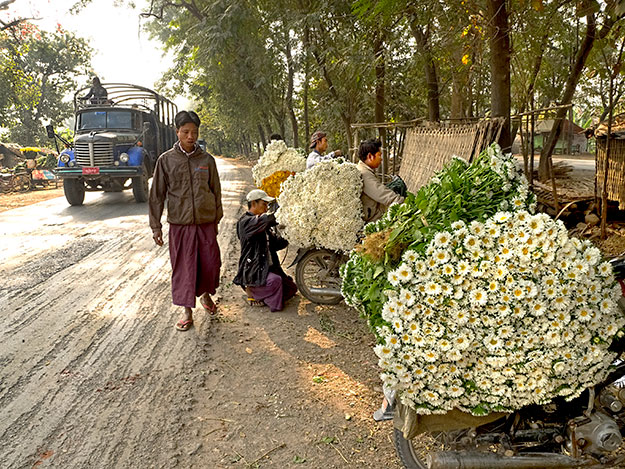
Today the city is an important center for silkworm farming, flower and vegetable production, and coffee plantations. It’s best known, however, as home to the National Kandawgyi Botanical Gardens, where I spent a pleasant couple of hours strolling through groves of mulberry trees and circuiting its lovely lake. In the afternoon, we visited two of the areas most famous temples. The first, Maha Ant Htoo Kan Thar Pagoda, is widely believed to have great power, thus locals who are visiting Pyin Oo Lwin always stop there first to make an offering.
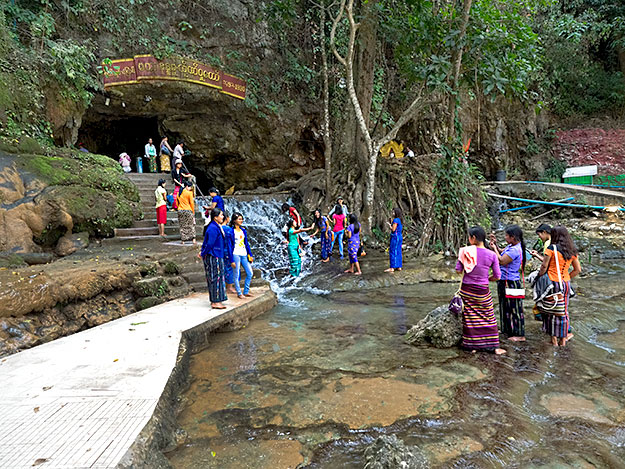
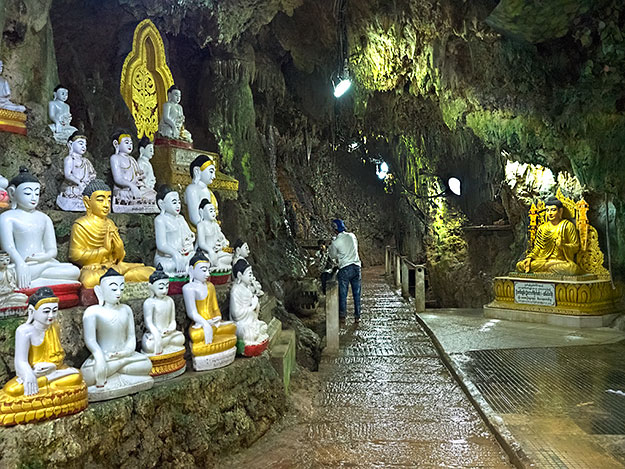
The second, Peik Chin Myaung Cave (also known as Maha Nan Damu Sacred Cave), is filled with thousands of Buddha statues. Like Shwedagon Pagoda in Yangon, the entire 45-acre site must be explored barefoot – no small task, considering I had to walk through the base of a waterfall and a 45-acre cave studded with limestone stalactites and stalagmites. By the time I finished, I was so tired and my feet were so sore that I ate a quick dinner at my hotel and climbed under a heap of blankets to ward off the chilly night temperatures.
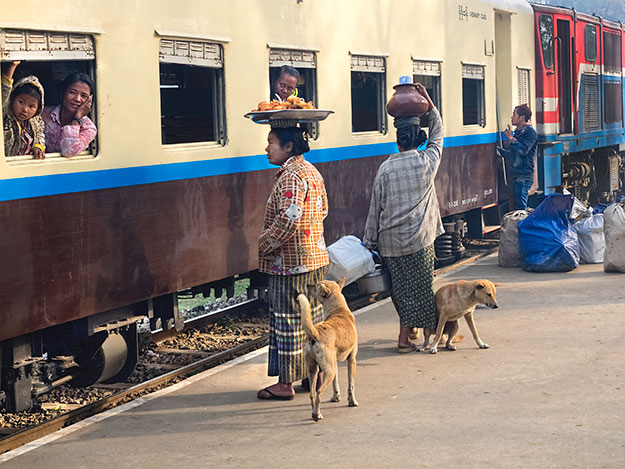
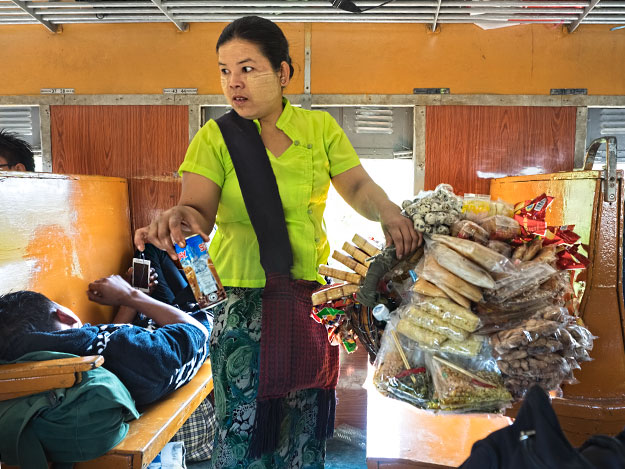
The following morning, we were bound for Hsipaw, but rather than driving, my guides dropped me at the local train station. Considered to be one of the world’s greatest train trips, the line between Pyin Oo Lwin and Hsipaw crosses the Gok Teik Gorge on what was once the largest railway trestle in the world and is still the highest bridge in Myanmar. I hopped aboard the rundown relic and scooted into an old wooden seat polished smooth from decades of use. Our ancient locomotive chugged along at the speed of a fast jogger, covering only 34 miles over the next four hours. Snapshots of life rolled by outside my window: farm workers in conical hats squatted in neat fields, women scrubbed laundry at village wells, and men herded oxen with sticks. Inside, vendors roamed the aisles selling everything from food to trinkets.
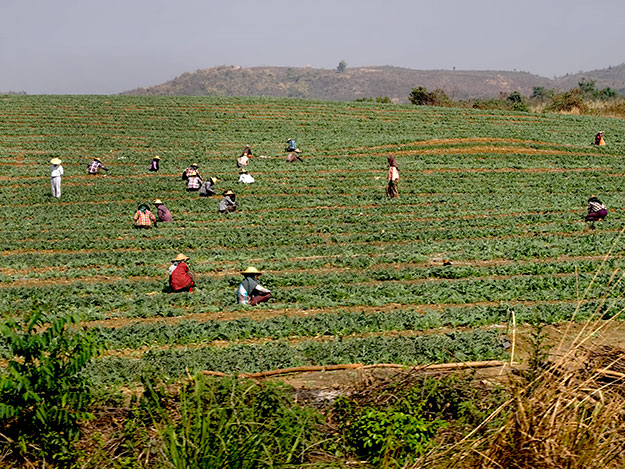
Metal screeching on metal, we crested 4,000 feet and began our descent toward the Gok Teik Viaduct. The British decided to build the bridge in 1899 in order to extend their control into the ethnic Shan territory of Burma. The U.S. contractor they hired, Pennsylvania and Maryland Bridge Construction, completed the 2,260-foot long, 335-foot high structure in less than a year. A marvel of engineering in its time, the viaduct has withstood bombings in World War II and terrorist attacks by ethnic groups, but over recent decades, maintenance has been spotty and the safety of the structure has come into question.
The soaring trestles appeared and disappeared as we navigated a series of switchbacks. At the edge of the gorge we slowed to a crawl and pulled out onto the frail-looking structure. I sprinted from side to side, trying to capture the experience on video, but didn’t breathe easy until we were back on solid ground on the opposite side of the chasm. Rather than continuing to Hsipaw, I left the train at the next station, Noung Peng, where my driver was waiting. Those who stayed aboard had another few hours ahead of them, while I was in Hsipaw within the hour.

In addition to being another of the pretty hill stations of Myanmar, Hsipaw offered a fascinating glimpse into the history of the Shan people. Once an autonomous state in Burma’s Shan Mountains, Hsipaw is the traditional home of the Shan princes. After completing his university education in Colorado, the last Saopha (prince) of Hsipaw, Sao Kya Seng, returned to Myanmar in 1953 with his Austrian wife, Inge Sargent. For nearly 12 years, the couple worked diligently to improve heath care, education, and the economic situation of the Shan people, until the prince was taken prisoner by the military during the 1962 military coup. He was never seen or heard from again and it is widely believed that he was murdered by the military. Inge stayed in Hsipaw two more years, trying to learn the fate of her husband, but when it became too dangerous to stay she escaped with her children.
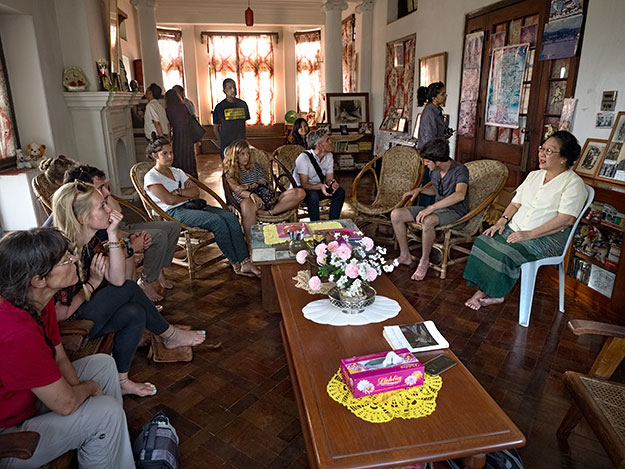
The old Shan Palace was left in the care of the prince’s nephew, Donald, and his wife, Fern. Donald was arrested in 2005 for saying negative things about the military regime and sentenced to 10 years in prison. He was released four years later during a general amnesty. Fearing further retribution, he now stays in the background, but Fern is committed to keeping the memory of the Saopha alive. I arrived at the old palace just before sunset and joined the group of tourists sitting in a circle in the living room. Quietly and with great dignity, Fern related the story of the Shan State over the last 50 years, with special focus on the oppression suffered by her people during the years the military ruled the country.

Too soon, it was time to head back to Mandalay, but not before a final stop in Pyin Oo Lwin to visit the unusual Chinese Temple and Cane Pagoda. At the latter, a site rarely visited by Westerners, my climb to the hilltop pagoda via a steep stairway was continually interrupted by people wanting to have their photo taken with me. I happily posed each time, but was somewhat mystified until I realized I was getting a dose of my own medicine. This must be exactly how people around the world feel when I ask to take their photos. As the only Westerner in sight, suddenly I was the exotic one.

Near the top of the hill, the steps grew broader and began to slope backward. Barefoot and already struggling like the tenderfoot I am, I slowed down even more to make sure I didn’t slip. Suddenly, a local woman appeared at my side and grabbed my hand. She smiled broadly, revealing a mouthful of betel nut-stained teeth, and said, “Two, easy.” Hand-in-hand, my forearm nestled against her ample bosom, we lumbered together to the top of the stairs, where her husband waited…to take a photo, of course.
Author’s note: In addition to offering an escape from brutal summer temperatures, the Hill Stations of Myanmar provide an opportunity to rub shoulders with members of the more than 135 ethnic groups that make up the population of Myanmar. The central market in Hsipaw is a particularly good place to see the Chinese, Chin, Karen, Kachin, and Shan peoples who trade from 3:30 to 6 a.m. each morning. The towns of Kyaukme and Lashio can now be visited by foreigners, and as the newly elected democratic government continues to settle grievances with ethnic minorities, other towns in the northern and eastern reaches of the country will undoubtedly be opened to tourism.

Hi Barb,
This was very interesting as we visited Maymyo in 1987. We stayed in a former British army outpost building turned into a hostel. I remember that their big thing was to serve a roast beef dinner to the travelers. It was an almost all day dusty, bumpy ride in a jeep on a very bad dirt road to get there from Mandalay. We rented bikes and biked around the town. There was a huge market where we bought several handy craft things from the locals. There was one main street. It was dirt and small stage coaches hauled people around town. The side walks were wood. It looked every bit like an old wild west town in old western movies.
Back then, I think we could only stay in the country for a week. We flew into Rangoon then on to Pagan and then on to Mandalay. Getting back to Mandalay was by a very slow overnight train. I suspect things are quite different now. We found the Burmese people to be some of the friendliest people of all the countries we visited on our 2 year RTW trip.
A couple months later, when we were in India, we read that the plane we flew on into Pagan, crashed. Needless to say, I really want to return some day.
Hi Steve: As you can no doubt see, things are changing quite rapidly in Myanmar. I hope you are able to visit soon, before things change too much. I really hope I don’t go back in a few years and say, “I saw it when.”
This is an excellent post. And Barb, you are one brave woman!!!
LOL – why do you say that Libbie? I wasn’t ever in any danger, except for maybe the two cases of food poisoning I got.